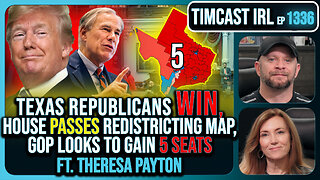Premium Only Content

Mnky Pox Becomes "Clade I & II" ~ An Extinction Event "Exercise" of Humans
Jwl Peace <jwlpeace@gmail.com>
Sun, Aug 14, 9:03 PM (13 hours ago)
to me, bcc: Aaron, bcc: Kenneth, bcc: alba.balice@comcast.net, bcc: Anthony, bcc: Ava, bcc: Lisz, bcc: Bread&Circus, bcc: Juan, bcc: Tre, bcc: Kristine, bcc: DANIEL, bcc: celestialrakiya, bcc: nelissa, bcc: Matthew, bcc: Doug, bcc: Elana, bcc: John, bcc: Fleming, bcc: Luis, bcc: Grant, bcc: Susanna, bcc: Lilly, bcc: tammy, bcc: Hanogi, bcc: Joshua, bcc: tate, bcc: Kingjerome@braxmail.net, bcc: Luna, bcc: Melanie, bcc: Phil, bcc: Patrick, bcc: Terry, bcc: Joann
image.png
monkey pox now polio and poop patrollers
https://www.youtube.com/watch?v=VoBVgPO2_-0&t=1s
The World Health Organization (WHO) announced Saturday that it renamed variants of the virus monkeypox as it looks to counter concerns about the original naming conventions.
Clade I and Clade II, the latter of which has two subclades. The new names go into effect immediately. A global expert group decided on the new naming convention “as part of ongoing efforts to align the names of the monkeypox disease, virus, and variants—or clades—with current best practices.
The term "clade" was coined in 1957 by the biologist Julian Huxley to refer to the result of cladogenesis, the evolutionary splitting of a parent species into two distinct species, a concept Huxley borrowed from Bernhard Rensch.[5][6] Many commonly named groups – rodents and insects, for example – are clades because, in each case, the group consists of a common ancestor with all its descendant branches. The name of a clade is conventionally a plural, where the singular refers to each member individually. A unique exception is the reptile clade Dracohors, which was made by haplology from Latin "draco" and "cohors", i.e. "the dragon cohort"; its form with a suffix added should be e.g. "dracohortian".
Cladogenesis is an evolutionary splitting of a parent species into two distinct species, forming a clade.[1]
This event usually occurs when a few organisms end up in new, often distant areas or when environmental changes cause several extinctions, opening up ecological niches for the survivors and causing population bottlenecks and founder effects changing allele frequencies of diverging populations compared to their ancestral population. The events that cause these species to originally separate from each other over distant areas may still allow both of the species to have equal chances of surviving, reproducing, and even evolving to better suit their environments while still being two distinct species due to subsequent natural selection, mutations and genetic drift.[2]
Testifying to human focus, bias and perhaps exceptionalism, humans have never been placed in a paraphyletic group, whereas most other organisms have been.[6]
Branches down to the divergence to the next significant (e.g. extant) sister are considered stem-groupings of the clade, but in principle each level stands on its own, to be assigned a unique name. For a fully bifurcated tree, adding a group to a tree also adds an additional (named) clade, and potentially a new level. Specifically, also extinct groups are always put on a side-branch, not distinguishing whether an actual ancestor of other groupings was found.
https://en.wikipedia.org/wiki/Clade
https://en.wikipedia.org/wiki/Cladistics
https://en.wikipedia.org/wiki/Cladogenesis
critical videos to prepare and be aware now
3 days of darkness
-
 9:43
9:43
Aplanetruth
2 years agoSlow Kill From Polio Vaxxines of the 1950's on Verified!
4.98K22 -
 2:29:46
2:29:46
FreshandFit
9 hours agoAfter Hours w/ Girls
125K87 -
 5:28
5:28
Zach Humphries
15 hours ago $2.18 earnedNEAR PROTCOL AND STELLAR TEAM UP!
28.5K3 -
 1:09:57
1:09:57
Brandon Gentile
1 day ago10,000 Hour BITCOIN Expert Reveals Why $13.5M Is Just The Start
31.2K7 -
 2:03:55
2:03:55
Badlands Media
10 hours agoDevolution Power Hour Ep. 382: DOJ Coverups, Clapper’s Team Sport & Trump’s Countermoves
143K25 -
 2:06:30
2:06:30
Inverted World Live
13 hours agoDon't Approach the Zombie Rabbits | Ep. 95
59.5K28 -
 3:26:45
3:26:45
Drew Hernandez
9 hours agoISRAEL PLANNING POSSIBLE DRAFT IN USA & TRUMP'S VIEW ON ETERNAL LIFE ANALYZED PT 2
47.7K65 -
 3:08:07
3:08:07
TimcastIRL
12 hours agoTexas Republicans Win, House Passes Redistricting Map, GOP Looks To Gain 5 Seats | Timcast IRL
204K111 -
 1:30:34
1:30:34
FreshandFit
12 hours agoHow To Stay Focused While Pursuing Women...The Good, The Bad, And The Ugly
69.5K42 -
 1:47:05
1:47:05
Drew Hernandez
17 hours agoISRAEL PLANNING POSSIBLE DRAFT IN USA & TRUMP'S VIEW ON ETERNAL LIFE ANALYZED PT 1
48K67